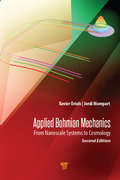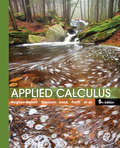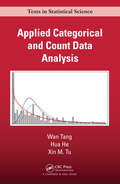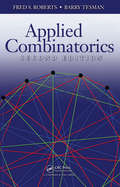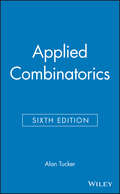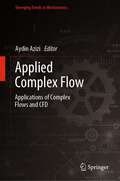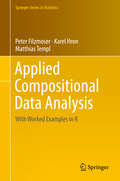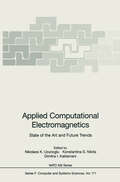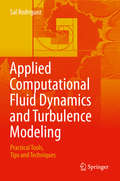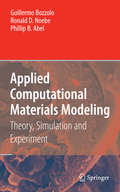- Table View
- List View
Applied Bohmian Mechanics: From Nanoscale Systems to Cosmology
by Xavier Oriols Pladevall Jordi MompartMost textbooks explain quantum mechanics as a story where each step follows naturally from the one preceding it. However, the development of quantum mechanics was exactly the opposite. It was a zigzag route, full of personal disputes where scientists were forced to abandon well-established classical concepts and to explore new and imaginative pathways. Some of the explored routes were successful in providing new mathematical formalisms capable of predicting experiments at the atomic scale. However, even such successful routes were painful enough, so that relevant scientists like Albert Einstein and Erwin Schrödinger decided not to support them. In this book, the authors demonstrate the huge practical utility of another of these routes in explaining quantum phenomena in many different research fields. Bohmian mechanics, the formulation of the quantum theory pioneered by Louis de Broglie and David Bohm, offers an alternative mathematical formulation of quantum phenomena in terms of quantum trajectories. Novel computational tools to explore physical scenarios that are currently computationally inaccessible, such as many-particle solutions of the Schrödinger equation, can be developed from it.
Applied Bohmian Mechanics: From Nanoscale Systems to Cosmology
by Xavier Oriols Pladevall Jordi MompartMost textbooks explain quantum mechanics as a story where each step follows naturally from the one preceding it. However, the development of quantum mechanics was exactly the opposite. It was a zigzag route, full of personal disputes where scientists were forced to abandon well-established classical concepts and to explore new and imaginative pathways. Some of the explored routes were successful in providing new mathematical formalisms capable of predicting experiments at the atomic scale. However, even such successful routes were painful enough, so that relevant scientists like Albert Einstein and Erwin Schrödinger decided not to support them. In this book, the authors demonstrate the huge practical utility of another of these routes in explaining quantum phenomena in many different research fields. Bohmian mechanics, the formulation of the quantum theory pioneered by Louis de Broglie and David Bohm, offers an alternative mathematical formulation of quantum phenomena in terms of quantum trajectories. Novel computational tools to explore physical scenarios that are currently computationally inaccessible, such as many-particle solutions of the Schrödinger equation, can be developed from it.
Applied Calculus
by Deborah Hughes-Hallett Andrew Gleason Patti Lock Daniel Flath Guadalupe Lozano Karen Rhea Eric Connally William McCallum Ayşe Şahin Selin Kalaycıoğlu Brad Osgood Adam Spiegler Brigitte Lahme Cody Patterson Jeff Tecosky-Feldman David Lomen Douglas Quinney Thomas Tucker David Lovelock Aaron WoottonApplied Calculus
by Deborah Hughes-Hallett Patti Frazer Lock Andrew M. Gleason Daniel E. Flath Sheldon P. Gordon David O. Lomen David Lovelock William G. McCallum Brad G. Osgood Andrew Pasquale Jeff Tecosky-Feldman Joseph Thrash Karen R Rhea Thomas W. TuckerApplied Calculus 5th Edition is praised for the creative and varied conceptual and modeling problems which motivate and challenge students. The 5th Edition of this market leading text exhibits the same strengths from earlier editions including the "Rule of Four," an emphasis on concepts and modeling, exposition that students can read and understand and a flexible approach to technology. Updated data and fresh applications throughout the book are designed to build student confidence with basic concepts and to reinforce skills. As in the previous edition, a Pre-test is included for students whose skills may need a refresher prior to taking the course.
Applied Calculus of Variations for Engineers
by Louis KomzsikThe purpose of the calculus of variations is to find optimal solutions to engineering problems whose optimum may be a certain quantity, shape, or function. Applied Calculus of Variations for Engineers addresses this important mathematical area applicable to many engineering disciplines. Its unique, application-oriented approach sets it apart from the theoretical treatises of most texts, as it is aimed at enhancing the engineer’s understanding of the topic.This Second Edition text:Contains new chapters discussing analytic solutions of variational problems and Lagrange-Hamilton equations of motion in depthProvides new sections detailing the boundary integral and finite element methods and their calculation techniquesIncludes enlightening new examples, such as the compression of a beam, the optimal cross section of beam under bending force, the solution of Laplace’s equation, and Poisson’s equation with various methodsApplied Calculus of Variations for Engineers, Second Edition extends the collection of techniques aiding the engineer in the application of the concepts of the calculus of variations.
Applied Calculus of Variations for Engineers
by Louis KomzsikThe purpose of the calculus of variations is to find optimal solutions to engineering problems whose optimum may be a certain quantity, shape, or function. Applied Calculus of Variations for Engineers addresses this important mathematical area applicable to many engineering disciplines. Its unique, application-oriented approach sets it apart from the theoretical treatises of most texts, as it is aimed at enhancing the engineer’s understanding of the topic.This Second Edition text:Contains new chapters discussing analytic solutions of variational problems and Lagrange-Hamilton equations of motion in depthProvides new sections detailing the boundary integral and finite element methods and their calculation techniquesIncludes enlightening new examples, such as the compression of a beam, the optimal cross section of beam under bending force, the solution of Laplace’s equation, and Poisson’s equation with various methodsApplied Calculus of Variations for Engineers, Second Edition extends the collection of techniques aiding the engineer in the application of the concepts of the calculus of variations.
Applied Calculus of Variations for Engineers, Third edition
by Louis KomzsikCalculus of variations has a long history. Its fundamentals were laid down by icons of mathematics like Euler and Lagrange. It was once heralded as the panacea for all engineering optimization problems by suggesting that allone needed to do was to state a variational problem, apply the appropriate Euler-Lagrange equation and solve the resulting differential equation. This, as most all encompassing solutions, turned out to be not always true and the resulting differential equations are not necessarily easy to solve. On the other hand, many of the differential equations commonly used in various fields of engineering are derived from a variational problem. Hence it is an extremely important topic justifying the new edition of this book. This third edition extends the focus of the book to academia and supports both variational calculus and mathematical modeling classes. The newly added sections, extended explanations, numerous examples and exercises aid the students in learning, the professors in teaching, and the engineers in applying variational concepts.
Applied Calculus of Variations for Engineers, Third edition
by Louis KomzsikCalculus of variations has a long history. Its fundamentals were laid down by icons of mathematics like Euler and Lagrange. It was once heralded as the panacea for all engineering optimization problems by suggesting that allone needed to do was to state a variational problem, apply the appropriate Euler-Lagrange equation and solve the resulting differential equation. This, as most all encompassing solutions, turned out to be not always true and the resulting differential equations are not necessarily easy to solve. On the other hand, many of the differential equations commonly used in various fields of engineering are derived from a variational problem. Hence it is an extremely important topic justifying the new edition of this book. This third edition extends the focus of the book to academia and supports both variational calculus and mathematical modeling classes. The newly added sections, extended explanations, numerous examples and exercises aid the students in learning, the professors in teaching, and the engineers in applying variational concepts.
Applied Calculus with R
by Thomas J. PfaffThis textbook integrates scientific programming with the use of R and uses it both as a tool for applied problems and to aid in learning calculus ideas. Adding R, which is free and used widely outside academia, introduces students to programming and expands the types of problems students can engage. There are no expectations that a student has any coding experience to use this text.While this is an applied calculus text including real world data sets, a student that decides to go on in mathematics should develop sufficient algebraic skills so that they can be successful in a more traditional second semester calculus course. Hopefully, the applications provide some motivation to learn techniques and theory and to take additional math courses. The book contains chapters in the appendix for algebra review as algebra skills can always be improved. Exercise sets and projects are included throughout with numerous exercises based on graphs.
Applied Categorical and Count Data Analysis (Chapman And Hall/crc Texts In Statistical Science Ser.)
by Wan TangDeveloped from the authors' graduate-level biostatistics course, Applied Categorical and Count Data Analysis explains how to perform the statistical analysis of discrete data, including categorical and count outcomes. The authors describe the basic ideas underlying each concept, model, and approach to give readers a good grasp of the fundamentals o
Applied Categorical and Count Data Analysis (Chapman & Hall/CRC Texts in Statistical Science)
by Wan Tang Hua He Xin M. TuDeveloped from the authors’ graduate-level biostatistics course, Applied Categorical and Count Data Analysis, Second Edition explains how to perform the statistical analysis of discrete data, including categorical and count outcomes. The authors have been teaching categorical data analysis courses at the University of Rochester and Tulane University for more than a decade. This book embodies their decade-long experience and insight in teaching and applying statistical models for categorical and count data. The authors describe the basic ideas underlying each concept, model, and approach to give readers a good grasp of the fundamentals of the methodology without relying on rigorous mathematical arguments. The second edition covers classic concepts and popular topics, such as contingency tables, logistic regression models, and Poisson regression models, along with modern areas that include models for zero-modified count outcomes, parametric and semiparametric longitudinal data analysis, reliability analysis, and methods for dealing with missing values. As in the first edition, R, SAS, SPSS, and Stata programming codes are provided for all the examples, enabling readers to immediately experiment with the data in the examples and even adapt or extend the codes to fit data from their own studies. Designed for a one-semester course for graduate and senior undergraduate students in biostatistics, this self-contained text is also suitable as a self-learning guide for biomedical and psychosocial researchers. It will help readers analyze data with discrete variables in a wide range of biomedical and psychosocial research fields. Features: -Describes the basic ideas underlying each concept and model. -Includes R, SAS, SPSS and Stata programming codes for all the examples -Features significantly expanded Chapters 4, 5, and 8 (Chapters 4-6, and 9 in the second edition. -Expands discussion for subtle issues in longitudinal and clustered data analysis such as time varying covariates and comparison of generalized linear mixed-effect models with GEE.
Applied Categorical and Count Data Analysis (Chapman & Hall/CRC Texts in Statistical Science)
by Wan Tang Hua He Xin M. TuDeveloped from the authors’ graduate-level biostatistics course, Applied Categorical and Count Data Analysis, Second Edition explains how to perform the statistical analysis of discrete data, including categorical and count outcomes. The authors have been teaching categorical data analysis courses at the University of Rochester and Tulane University for more than a decade. This book embodies their decade-long experience and insight in teaching and applying statistical models for categorical and count data. The authors describe the basic ideas underlying each concept, model, and approach to give readers a good grasp of the fundamentals of the methodology without relying on rigorous mathematical arguments. The second edition covers classic concepts and popular topics, such as contingency tables, logistic regression models, and Poisson regression models, along with modern areas that include models for zero-modified count outcomes, parametric and semiparametric longitudinal data analysis, reliability analysis, and methods for dealing with missing values. As in the first edition, R, SAS, SPSS, and Stata programming codes are provided for all the examples, enabling readers to immediately experiment with the data in the examples and even adapt or extend the codes to fit data from their own studies. Designed for a one-semester course for graduate and senior undergraduate students in biostatistics, this self-contained text is also suitable as a self-learning guide for biomedical and psychosocial researchers. It will help readers analyze data with discrete variables in a wide range of biomedical and psychosocial research fields. Features: -Describes the basic ideas underlying each concept and model. -Includes R, SAS, SPSS and Stata programming codes for all the examples -Features significantly expanded Chapters 4, 5, and 8 (Chapters 4-6, and 9 in the second edition. -Expands discussion for subtle issues in longitudinal and clustered data analysis such as time varying covariates and comparison of generalized linear mixed-effect models with GEE.
Applied Chemistry and Chemical Engineering, Volume 1: Mathematical and Analytical Techniques
by A. K. Haghi Devrim Balköse Omari V. Mukbaniani Andrew G. MercaderThis new book brings together innovative research, new concepts, and novel developments in the application of informatics tools for applied chemistry and computer science. It presents a modern approach to modeling and calculation and also looks at experimental design in applied chemistry and chemical engineering. The volume discusses the developments of advanced chemical products and respective tools to characterize and predict the chemical material properties and behavior. Providing numerous comparisons of different methods with one another and with different experiments, not only does this book summarize the classical theories, but it also exhibits their engineering applications in response to the current key issues. Recent trends in several areas of chemistry and chemical engineering science, which have important application to practice, are discussed. Applied Chemistry and Chemical Engineering: Volume 1: Mathematical and Analytical Techniques provides valuable information for chemical engineers and researchers as well as for graduate students. It demonstrates the progress and promise for developing chemical materials that seem capable of moving this field from laboratory-scale prototypes to actual industrial applications. Volume 2 will focus principles and methodologies in applied chemistry and chemical engineering.
Applied Chemistry and Chemical Engineering, Volume 1: Mathematical and Analytical Techniques
by A. K. Haghi Devrim Balkose Omari V. Mukbaniani Andrew G. MercaderThis new book brings together innovative research, new concepts, and novel developments in the application of informatics tools for applied chemistry and computer science. It presents a modern approach to modeling and calculation and also looks at experimental design in applied chemistry and chemical engineering. The volume discusses the developments of advanced chemical products and respective tools to characterize and predict the chemical material properties and behavior. Providing numerous comparisons of different methods with one another and with different experiments, not only does this book summarize the classical theories, but it also exhibits their engineering applications in response to the current key issues. Recent trends in several areas of chemistry and chemical engineering science, which have important application to practice, are discussed. Applied Chemistry and Chemical Engineering: Volume 1: Mathematical and Analytical Techniques provides valuable information for chemical engineers and researchers as well as for graduate students. It demonstrates the progress and promise for developing chemical materials that seem capable of moving this field from laboratory-scale prototypes to actual industrial applications. Volume 2 will focus principles and methodologies in applied chemistry and chemical engineering.
Applied Chemistry and Chemical Engineering, Volume 2: Principles, Methodology, and Evaluation Methods
by A. K. Haghi Lionello Pogliani Devrim Balkose Omari V. Mukbaniani Andrew G. MercaderThis book covers many important aspects of applied chemistry and chemical engineering, focusing on three main aspects: principles, methodology and evaluation methods. It presents a selection of chapters on recent developments of theoretical, mathematical, and computational conceptions, as well as chapters on modeling and simulation of specific research themes covering applied chemistry and chemical engineering. This book attempts to bridge the gap between classical analysis and modern applications. Covering a selection of topics within the field of applied chemistry and chemical engineering, the book is divided into several parts: polymer chemistry and technology bioorganic and biological chemistry nanoscale technology selected topics This book is the second of the two-volume series Applied Chemistry and Chemical Engineering. The first volume is Volume 1: Mathematical and Analytical Techniques.
Applied Chemistry and Chemical Engineering, Volume 2: Principles, Methodology, and Evaluation Methods
by A. K. Haghi Lionello Pogliani Devrim Balköse Omari V. Mukbaniani Andrew G. MercaderThis book covers many important aspects of applied chemistry and chemical engineering, focusing on three main aspects: principles, methodology and evaluation methods. It presents a selection of chapters on recent developments of theoretical, mathematical, and computational conceptions, as well as chapters on modeling and simulation of specific research themes covering applied chemistry and chemical engineering. This book attempts to bridge the gap between classical analysis and modern applications. Covering a selection of topics within the field of applied chemistry and chemical engineering, the book is divided into several parts: polymer chemistry and technology bioorganic and biological chemistry nanoscale technology selected topics This book is the second of the two-volume series Applied Chemistry and Chemical Engineering. The first volume is Volume 1: Mathematical and Analytical Techniques.
Applied Chemistry and Chemical Engineering, Volume 3: Interdisciplinary Approaches to Theory and Modeling with Applications
by A. K. Haghi Lionello Pogliani Francisco Torrens Devrim Balköse Omari V. MukbanianiUnderstanding mathematical modeling is fundamental in chemical engineering. This book reviews, introduces, and develops the mathematical models that are most frequently encountered in sophisticated chemical engineering domains. The volume provides a collection of models illustrating the power and richness of the mathematical sciences in supplying insight into the operation of important real-world systems. It fills a gap within modeling texts, focusing on applications across a broad range of disciplines. The first part of the book discusses the general components of the modeling process and highlights the potential of modeling in the production of nanofibers. These chapters discuss the general components of the modeling process and the evolutionary nature of successful model building in the electrospinning process. Electrospinning is the most versatile technique for the preparation of continuous nanofibers obtained from numerous materials. This section of book summarizes the state-of-the art in electrospinning as well as updates on theoretical aspects and applications. Part 2 of the book presents a selection of special topics on issues in applied chemistry and chemical engineering, including nanocomposite coating processes by electrocodeposition method, entropic factors conformational interactions, and the application of artificial neural network and meta-heuristic algorithms. This volume covers a wide range of topics in mathematical modeling, computational science, and applied mathematics. It presents a wealth of new results in the development of modeling theories and methods, advancing diverse areas of applications and promoting interdisciplinary interactions between mathematicians, scientists, engineers and representatives from other disciplines.
Applied Chemistry and Chemical Engineering, Volume 3: Interdisciplinary Approaches to Theory and Modeling with Applications
by A. K. Haghi Lionello Pogliani Francisco Torrens Devrim Balköse Omari V. Mukbaniani Andrew G. MercaderUnderstanding mathematical modeling is fundamental in chemical engineering. This book reviews, introduces, and develops the mathematical models that are most frequently encountered in sophisticated chemical engineering domains. The volume provides a collection of models illustrating the power and richness of the mathematical sciences in supplying insight into the operation of important real-world systems. It fills a gap within modeling texts, focusing on applications across a broad range of disciplines. The first part of the book discusses the general components of the modeling process and highlights the potential of modeling in the production of nanofibers. These chapters discuss the general components of the modeling process and the evolutionary nature of successful model building in the electrospinning process. Electrospinning is the most versatile technique for the preparation of continuous nanofibers obtained from numerous materials. This section of book summarizes the state-of-the art in electrospinning as well as updates on theoretical aspects and applications. Part 2 of the book presents a selection of special topics on issues in applied chemistry and chemical engineering, including nanocomposite coating processes by electrocodeposition method, entropic factors conformational interactions, and the application of artificial neural network and meta-heuristic algorithms. This volume covers a wide range of topics in mathematical modeling, computational science, and applied mathematics. It presents a wealth of new results in the development of modeling theories and methods, advancing diverse areas of applications and promoting interdisciplinary interactions between mathematicians, scientists, engineers and representatives from other disciplines.
Applied Combinatorics
by Fred Roberts Barry TesmanNow with solutions to selected problems, Applied Combinatorics, Second Edition presents the tools of combinatorics from an applied point of view. This bestselling textbook offers numerous references to the literature of combinatorics and its applications that enable readers to delve more deeply into the topics.After introducing fundamental counting
Applied Combinatorics
by Alan TuckerThe new 6th edition of Applied Combinatorics builds on the previous editions with more in depth analysis of computer systems in order to help develop proficiency in basic discrete math problem solving. As one of the most widely used books in combinatorial problems, this edition explains how to reason and model combinatorically while stressing the systematic analysis of different possibilities, exploration of the logical structure of a problem, and ingenuity. Although important uses of combinatorics in computer science, operations research, and finite probability are mentioned, these applications are often used solely for motivation. Numerical examples involving the same concepts use more interesting settings such as poker probabilities or logical games.
Applied Complex Flow: Applications of Complex Flows and CFD (Emerging Trends in Mechatronics)
by Aydin AziziThis book presents improved numerical techniques and applied computer-aided simulations as a part of emerging trends in mechatronics in all areas related to complex fluids, with particular focus on using a combination of modeling, theory, and simulation to study systems that are complex due to the rheology of fluids (i.e., ceramic pastes, polymer solutions and melts, colloidal suspensions, emulsions, foams, micro-/nanofluids, etc.) and multiphysics phenomena in which the interactions of various effects (thermal, chemical, electric, magnetic, or mechanical) lead to complex dynamics. The areas of applications span materials processing, manufacturing, and biology.
Applied Compositional Data Analysis: With Worked Examples In R (Springer Series in Statistics)
by Peter Filzmoser Matthias Templ Karel HronThis book presents the statistical analysis of compositional data using the log-ratio approach. It includes a wide range of classical and robust statistical methods adapted for compositional data analysis, such as supervised and unsupervised methods like PCA, correlation analysis, classification and regression. In addition, it considers special data structures like high-dimensional compositions and compositional tables. The methodology introduced is also frequently compared to methods which ignore the specific nature of compositional data. It focuses on practical aspects of compositional data analysis rather than on detailed theoretical derivations, thus issues like graphical visualization and preprocessing (treatment of missing values, zeros, outliers and similar artifacts) form an important part of the book. Since it is primarily intended for researchers and students from applied fields like geochemistry, chemometrics, biology and natural sciences, economics, and social sciences, all the proposed methods are accompanied by worked-out examples in R using the package robCompositions.
Applied Computational Electromagnetics: State of the Art and Future Trends (NATO ASI Subseries F: #171)
by Nikolaos K. Uzunoglu Konstantina S. Nikita Dimitra I. Kaklamani@EOI: AEI rEOMETPEI Epigram of the Academy of Plato in Athens Electromagnetism, the science of forces arising from Amber (HAEKTPON) and the stone of Magnesia (MArNHLIA), has been the fOWldation of major scientific breakthroughs, such as Quantum Mechanics and Theory of Relativity, as well as most leading edge technologies of the twentieth century. The accuracy of electromagnetic fields computations for engineering purposes has been significantly improved during the last decades, due to the deVelopment of efficient computational techniques and the availability of high performance computing. The present book is based on the contributions and discussions developed during the NATO Advanced Study Institute on Applied Computational Electromagnetics: State of the Art and Future Trends, which has taken place in Hellas, on the island of Samos, very close to the birthplace of Electromagnetism. The book covers the fundamental concepts, recent developments and advanced applications of Integral Equation and Metliod of Moments Techniques, Finite Element and BOWldary Element Methods, Finite Difference Time Domain and Transmission Line Methods. Furthermore, topics related to Computational Electromagnetics, such as Inverse Scattering, Semi-Analytical Methods and Parallel Processing Techniques are included. The collective presentation of the principal computational electromagnetics techniques, developed to handle diverse challenging leading edge technology problems, is expected to be useful to researchers and postgraduate students working in various topics of electromagnetic technologies.
Applied Computational Fluid Dynamics and Turbulence Modeling: Practical Tools, Tips and Techniques
by Sal RodriguezThis unique text provides engineering students and practicing professionals with a comprehensive set of practical, hands-on guidelines and dozens of step-by-step examples for performing state-of-the-art, reliable computational fluid dynamics (CFD) and turbulence modeling. Key CFD and turbulence programs are included as well. The text first reviews basic CFD theory, and then details advanced applied theories for estimating turbulence, including new algorithms created by the author. The book gives practical advice on selecting appropriate turbulence models and presents best CFD practices for modeling and generating reliable simulations. The author gathered and developed the book’s hundreds of tips, tricks, and examples over three decades of research and development at three national laboratories and at the University of New Mexico—many in print for the first time in this book. The book also places a strong emphasis on recent CFD and turbulence advancements found in the literature over the past five to 10 years. Readers can apply the author’s advice and insights whether using commercial or national laboratory software such as ANSYS Fluent, STAR-CCM, COMSOL, Flownex, SimScale, OpenFOAM, Fuego, KIVA, BIGHORN, or their own computational tools. Applied Computational Fluid Dynamics and Turbulence Modeling is a practical, complementary companion for academic CFD textbooks and senior project courses in mechanical, civil, chemical, and nuclear engineering; senior undergraduate and graduate CFD and turbulence modeling courses; and for professionals developing commercial and research applications.
Applied Computational Materials Modeling: Theory, Simulation and Experiment
by Guillermo Bozzolo Ronald D. Noebe Phillip B. AbelThe scope of this book is to identify and emphasize the successful link between computational materials modeling as a simulation and design tool and its synergistic application to experimental research and alloy development. The book provides a more balanced perspective of the role that computational modeling can play in every day research and development efforts. Each chapter describes one or more particular computational tool and how they are best used.
